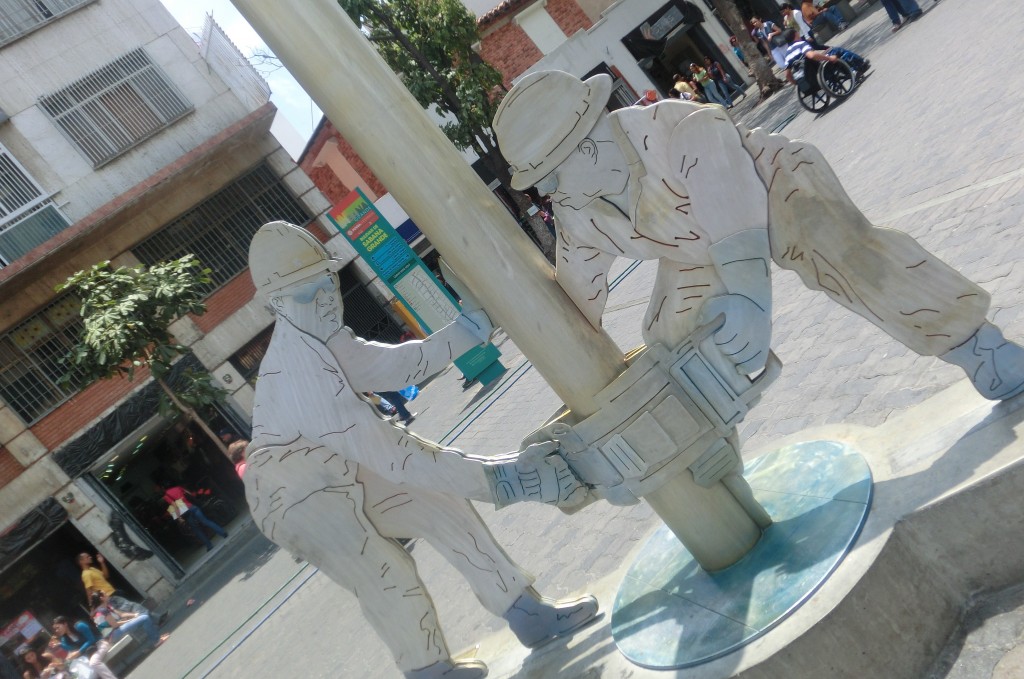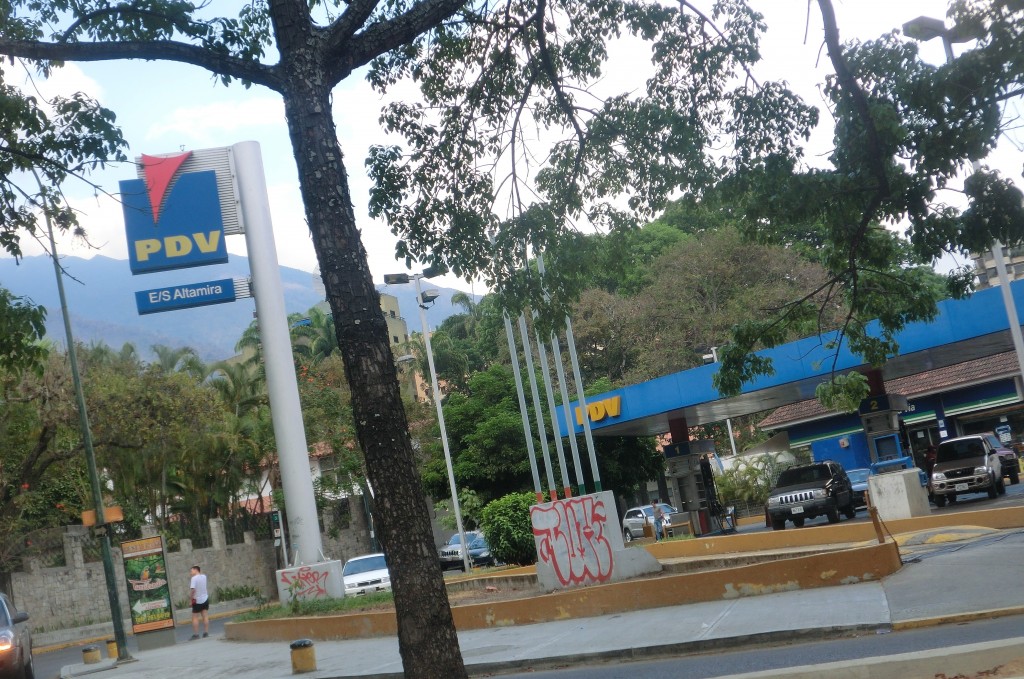CARACAS, Venezuela — You’d think in Caracas that the governing party were the PDVSA, not the PSUV.![]()
But the state-owned oil company, Petróleos de Venezuela, S.A., functions as much as any other organ in Venezuela in service of the government, formerly headed by Hugo Chávez and now, Nicolás Maduro.
Indeed, a stroll through Caracas finds the PDVSA brand saturates the city — much more than the nominal governing party, the Partido Socialista Unido de Venezuela (United Socialist Party of Venezuela). Here’s a PDVSA-branded hopscotch:
PDVSA (pronounce it ‘pay-duh-vay-suh’) was founded in 1976 when then-president Carlos Andrés Pérez nationalized the oil industry at the height of an oil boom the likes of which Venezuela had never seen. Venezuela’s oil industry began in 1914 when the first oil well was drilled in Mene Grande, in western Zulia. It began exporting petroleum by 1918, and that soon eclipsed an economy once based largely on cacao and coffee — though cacao production was dwindling in the early 20th century, Venezuela exported more coffee than any country in the world other than neighboring Brazil.
Venezuela was the world’s leading oil exporter by the end of the 1920s — Caracas was known as ‘the gas station south of Florida.’ We think of the Organization of Petroleum-Exporting Countries (OPEC) as a largely Middle Eastern cartel today, but it was founded in large part in 1960 on the initiative of Venezuelan energy minister Juan Pablo Pérez Alfonso, who helped create it after reaching out to his ministerial counterparts in Saudi Arabia.
Through the next 40 years, Venezuela’s fortunes rose and fell with global oil price, but PDVSA remained relatively at arm’s length from the government — it paid income taxes and royalties to the government, as well as dividends (because it’s entirely state-owned).
This continued even after Chávez was elected — until 2002, that is, when Chávez attempted to take control of PDVSA, leading to a rebellion/coup attempt and a general strike among PDVSA employees later that year. Chávez, as it turns out, simply fired most of the offenders, and over the past 11 years, PDVSA has become essentially an arm of the government, which itself increasingly became an organ of chavismo.
So PDVSA employees today wear red, the color of chavismo, and over the past decade, PDVSA has been a direct contributor of funds to social programs, bypassing the formal channels of government — and also incurring its own liabilities (indeed, the IMF’s estimate of Venezuela’s public debt of around 51% includes PDVSA debts as well).
Whatever the benefits to deploying that capital for social welfare programs (and I’m not arguing for or against), it means there’s simply less capital to maintain production or develop new avenues for refining oil.
Rafael Ramírez, a loyal chavista, was appointed minister of energy and petroleum in 2002 and PDVSA’s president in 2004. If Maduro wins the election, it’s expected that Ramírez will stay in place — and so will continuity in oil policy under the Maduro administration. If Maduro replaces Ramírez, however, it could be an indication that he wants to shake up some of his predecessor’s policies.
Oil proceeds represent around 95% of Venezuela’s exports, around 20% of its GDP and over 50% of the government budget. So what happens in the oil industry matters for what happens with Venezuela’s government and its economy.
One of the outset problems is that we don’t even know how much oil Venezuela is producing. PDVSA’s own figures claim that it’s pumping 2.92 barrels per day (bpd). But industry experts and OPEC reports claim that it is much less. In any event, it’s not disputed that product has fallen off — by up to a third, perhaps — since 2002. That’s despite the development of additional oil in the Orinoco Belt, and an OPEC estimate in 2012 that Venezuela has the largest share of global oil reserves (24.8%), outdoing even Saudi Arabia (22.1%).
Luis Ramírez, president of the Venezuelan-American Chamber of Commerce, worked for PDVSA until the early 2000s, and since 2005, he’s worked in Miami, and he thinks the official numbers could be far off as well.
‘In the early 2000s, [PDVSA produced] 3.3 billion barrels a day,’ he said. ‘The last official figure that I knew of was 2.7 million barrels a day. I’ve heard of figures as low as 2.5, 2.4 billion barrels a day. That’s at least 600,000 bpd. That’s a big chunk of what we used to produce.’
What’s clear (or perhaps, ironic, given the poor bilateral diplomatic ties between the two) is that the United States remains, even today, Venezuelan’s largest customer, buying around 900,000 bpd (it bought 871,000 bpd in January 2013).
Venezuela, on the basis of financing deals with China, is now exporting at least 300,000 bpd to China in exchange for pending loans or loans it’s already received, with perhaps over another 300,000 bpd directly. According to a 2011 estimate from the U.S. Energy Information Administration, while the United States purchases 40% of Venezuelan oil exports and China purchases just 10%, fully 31% goes to the Caribbean. Much of that is to Aruba and the Netherlands Antilles, which now have quality refining capability. But around 120,000 bpd is provided to Cuba at a discount, largely in exchange for medical and other technical experts in Venezuela.
Even with the rise in exports to China, geography dictates why the United States remains a much more important purchaser — a tanker can get to the Gulf Coast in two days. But the rising cost of oil in the past decade makes it much more economically rational to ship oil from Venezuela to China, which may take three or four weeks. Another 30,000 bpd each go to Nicaragua and the Dominican Republic, again discounted, along with other countries pursuant to PetroCaribe, which Chávez created in 2005 among his Caribbean and Central American allies to strengthen further regional ties.
In addition, Venezuela keeps some of its own oil at home — and is importing an increasing number of refined oil products — to provide a gas subsidy to domestic consumers that costs up to 4.6% of GDP. Venezuelans, who literally rioted in 1989 in the wake of an IMF economic package that attempted to eliminate the subsidy, consider cheap gas akin to something of a de facto constitutionally enshrined right. So Venezuelans have the cheapest gas in the world — $0.06 per gallon.
Juan Fernández, another Miami-based oil analyst who was a 20-year veteran administrator at PdVSA, says that Venezuela could potentially produce up to 8 million bpd of oil with the right investment, but notes that its refineries remain in poor shape. He added that the quality of Venezuela’s crude oil is heavy or extra heavy, especially the newly developed Orinoco Belt crude oil — it’s so heavy that early Spanish explorers reported that natives used the oil to seal their canoes. Accordingly, that’s made PDVSA’s need to invest further in its cleaning and refining capability all the more crucial.
‘Light and medium crude oil is something that we have, of course, but the [most important] is heavy and extra heavy crude oil,’ Feranández said. ‘We can upgrade the oil into a very [high-quality] light crude or a very heavy crude oil. The difference will be the amount of investment. So if you are looking for just, let’s say, heavy crude, it’s not possible to do 3 or 4 million barrels a day.’
Photo credit to Kevin Lees — Caracas, Venezuela, April 2013.




3 thoughts on “A primer on PDVSA — and the interaction of oil and politics in Venezuela”